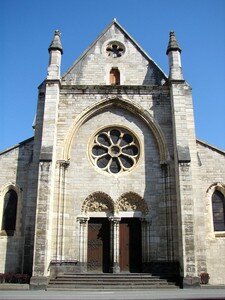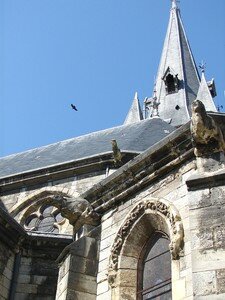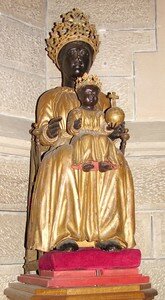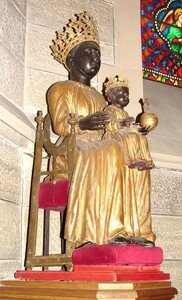Saint-Saturnin of Cusset
 Cussiacus
fundus, at the time Gallo-Roman, left us few traces: elements of
hypocauste and ceramics were put at the day places Victor-Hugo in 1992
and passage of Valmy in 1994. Gallo-Roman period vestiges of aqueducts
and hypocauste were discovered which attests presence of a villa.
Cussiacus
fundus, at the time Gallo-Roman, left us few traces: elements of
hypocauste and ceramics were put at the day places Victor-Hugo in 1992
and passage of Valmy in 1994. Gallo-Roman period vestiges of aqueducts
and hypocauste were discovered which attests presence of a villa.
In 886, Eumène, bishop of Nevers, melt a Benedictine abbey women (the building is occupied today by the town hall).
On
July 17, 1440, the dolphin Louis, future Louis XI, was reconciled there
with his/her father Charles VII, putting thus fine at Praguerie.
 Louis
XI become king, it makes rebuild the fortifications of the city by the
project superintendent Vauzy of Saint Martin's day, of 1476 to 1483.
With their walls with embossings, their drain-holes with embrasures
with the Frenchwoman (in X), they constitute the prototype of the
modern fortification, able to answer the attacks of the metal balls;
Vauban will make use of it of model. Destroyed gradually starting from
the XVIIème century, it as a subisist only one tower (which shelters
the museum) and the undergrounds, i.e. galleries of ground floor of the
doors which were found buried during the filling of the ditches.
Louis
XI become king, it makes rebuild the fortifications of the city by the
project superintendent Vauzy of Saint Martin's day, of 1476 to 1483.
With their walls with embossings, their drain-holes with embrasures
with the Frenchwoman (in X), they constitute the prototype of the
modern fortification, able to answer the attacks of the metal balls;
Vauban will make use of it of model. Destroyed gradually starting from
the XVIIème century, it as a subisist only one tower (which shelters
the museum) and the undergrounds, i.e. galleries of ground floor of the
doors which were found buried during the filling of the ditches.
An
abbey of chocolate éclairs bénédictines is installed by Eumène, bishop
of Nevers. It imposes a true domination on the city during several
centuries while contributing to its development.
 In
XIème century, Cusset, place of transit between Bourbonnais, Auvergne
and the provinces of the center, are the seat many fairs. The
population increases, also attracted by the court of the bailliage to
the black Virgin. In XIIIème century, the first fortifications surround
“the only city which was royal field in Combining and the Loire”, dixit
Philippe the Beautiful one.
In
XIème century, Cusset, place of transit between Bourbonnais, Auvergne
and the provinces of the center, are the seat many fairs. The
population increases, also attracted by the court of the bailliage to
the black Virgin. In XIIIème century, the first fortifications surround
“the only city which was royal field in Combining and the Loire”, dixit
Philippe the Beautiful one.
The parish church Saint-Saturnin, medieval, was rebuilt for reasons
of outdatedness between 1859 and 1868, in the fields of the Parisian
architect Jean-baptiste Lassus (1807-1857) who chose a building in the
taste of XIIIème century.
The church is dedicated to Saturnin,
bishop of Toulouse, martyrized in the years 250-251; shown to make dumb
the oracle of the temple pagan, it was attached to a bull and had the
crashed to pieces head when the animal started to descend the staircase
of Capitole. It is considered to cure the men of the giddiness and the
sheep of the disease of tournis.
 The
church exeptionnellement is exeptionnellement directed in north, and
not in the east for problems of place within urban fabric. The plan is
basilical, the nonprojecting transept. The nave with 6 spans is flanked
sides. The bedside with déambulatoire is surrounded by two sacristies,
of the turret of the staircase of the bell-tower and 3 pentagonal
radiating chapels. The building, whose base is out of stone of Volvic,
is built out of stone of Gannat and the decorations carved out of stone
of Apremont.
The
church exeptionnellement is exeptionnellement directed in north, and
not in the east for problems of place within urban fabric. The plan is
basilical, the nonprojecting transept. The nave with 6 spans is flanked
sides. The bedside with déambulatoire is surrounded by two sacristies,
of the turret of the staircase of the bell-tower and 3 pentagonal
radiating chapels. The building, whose base is out of stone of Volvic,
is built out of stone of Gannat and the decorations carved out of stone
of Apremont. For
these decorations, Lassus took as a starting point the the notebooks of
sketch of Villard de Honnecourt which it had discovered with the
imperial library and makes publish.
For
these decorations, Lassus took as a starting point the the notebooks of
sketch of Villard de Honnecourt which it had discovered with the
imperial library and makes publish.
 The
gate of the principal frontage is divided into two parts. The lintels
are engraved Latin inscriptions pointing out the history of
construction. Inside, the capitals are carved by Martial Liandrat.
The
gate of the principal frontage is divided into two parts. The lintels
are engraved Latin inscriptions pointing out the history of
construction. Inside, the capitals are carved by Martial Liandrat.
The black virgin
 The
current statue is a copy of substitution. One still has the hands of
the old statue, in the treasure of the church. They are dated from Xème
century and are decorated bracelets of vermeil on which cups are fixed
containing a chalcedony for the left hand and the right hand two
cornalines, Roman intaglios representing Athéna-Minerve and a bouquet
with a rudder.
The
current statue is a copy of substitution. One still has the hands of
the old statue, in the treasure of the church. They are dated from Xème
century and are decorated bracelets of vermeil on which cups are fixed
containing a chalcedony for the left hand and the right hand two
cornalines, Roman intaglios representing Athéna-Minerve and a bouquet
with a rudder. 
 The
statue was found towards Xème century, according to the legend, on a
fountain of the abbey of Cusset. The worship of Notre-Dame de Cusset
was considerable and the kings of France Louis XI and Philippe the
Beautiful one honoured it and covered it gifts. In 1629, it stopped the
plague which devastated the city.
The
statue was found towards Xème century, according to the legend, on a
fountain of the abbey of Cusset. The worship of Notre-Dame de Cusset
was considerable and the kings of France Louis XI and Philippe the
Beautiful one honoured it and covered it gifts. In 1629, it stopped the
plague which devastated the city.
 But
celà did not prevent the statue from being destroyed with the
revolution, and in spite of the new statue remade with the manner of
old, its worship, which was one of largest the pélerinages to the
Middle Ages, fell into the lapse of memory. (Jacques Bonvin, black
Virgins)
But
celà did not prevent the statue from being destroyed with the
revolution, and in spite of the new statue remade with the manner of
old, its worship, which was one of largest the pélerinages to the
Middle Ages, fell into the lapse of memory. (Jacques Bonvin, black
Virgins)
http://fr.wikipedia.org/wiki/Cusset
http://www.ville-cusset.fr/laville/monum1.htm

/https%3A%2F%2Fprofilepics.canalblog.com%2Fprofilepics%2F1%2F1%2F116167.jpg)
/https%3A%2F%2Fstorage.canalblog.com%2F49%2F16%2F312499%2F14620054_o.jpg)
/https%3A%2F%2Fstorage.canalblog.com%2F53%2F18%2F312499%2F14151229_o.jpg)
/https%3A%2F%2Fstorage.canalblog.com%2F07%2F05%2F312499%2F14149867_o.jpg)
/https%3A%2F%2Fstorage.canalblog.com%2F11%2F35%2F312499%2F14149307_o.jpg)
/https%3A%2F%2Fstorage.canalblog.com%2F90%2F14%2F312499%2F14125247_o.jpg)



/https%3A%2F%2Fstorage.canalblog.com%2F12%2F98%2F137895%2F6624411_p.jpg)
/https%3A%2F%2Fstorage.canalblog.com%2F34%2F82%2F137895%2F27207854_p.jpg)
/https%3A%2F%2Fstorage.canalblog.com%2F32%2F37%2F137895%2F15872299_p.jpg)
/https%3A%2F%2Fstorage.canalblog.com%2F37%2F81%2F137895%2F15879822_p.jpg)